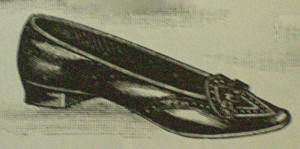Tuesday’s Tips & Tricks
Historically Inspired Shoes
All costumers know the difficulty involved in finding shoes that are historically accurate. Genuine antique shoes are expensive, hard to find, hard to fit, and may not be in good enough condition to actually wear. Then there’s the quandary of should you wear a pair of antique shoes, or instead preserve them for future generations?
You can find reproduction shoes that are accurate, but they certainly are not cheap. Prices typically start around $80 for a good pair, and can reach upwards of $200 or more. They are especially hard to find in wide widths, which makes it difficult for many to find shoes that fit.
Victorian “granny boots” are plentiful on eBay, and other online venues, but there are several factors to consider.
Heel Shape: Modern boots sometimes have cowboy or modern spike heels, both of which are historically inaccurate. Look for curved “French” or “Louis” heels, or low, straight heels.
Speed Hooks: Some lace-up boots have so-called speed lacers, which are metal hooks that make lacing the shoes fast and easy. These did appear on shoes in the 1890s, so they’re historically correct. However, these hooks often get caught on lace petticoats, making them a hazard for historical dressers—especially those who wear genuine antique petticoats.
Zippers: Many boots come with a zipper up the side or back to make it easier to get on and off. Zippers were not in general use until after World War I, so be cautious if you’re looking for accuracy. Examine photos of the shoes carefully, because descriptions don’t always mention zippers.
For those interested in reproduction shoes, here is a short list of websites that sell them. (Disclaimer: I have not personally used any of these sites, so I cannot vouch for their service or authenticity.)
- Fugawee offers mid 19th century and 18thcentury shoes for women.
- Robert Land offers mid and early 19th century shoes for women, and a wide range for men.
- Sarah Juniper makes women’s shoes from ancient times through the early 19th century.
- Oak Tree Farms carries a range of women’s Victorian boots.
- NP Historical Shoes creates shoes from ancient times through the 18th century.
What if you can’t afford reproductions? For me, accuracy is important, but comfort is foremost, with price a close second. If they fit and the price is right, I’m willing to try shoes that give the impression of being historic, even if they’re not completely authentic. Keep on the watch and eventually you’ll find a pair that are reasonably priced and that come in a broad range of sizes and widths. You can find such shoes at sites like ShoeMall, Zappos, and ShoeBuy. As an added benefit, such websites usually offer free return shipping if you find that the shoes don’t fit.
Here are a few examples.
- Grace by Dyeables®is a dress shoe that has a good shape for 18thor 19th century evening shoes. As a bonus, they can be dyed any color.
- Grace by Easy Street® has a good shape for the 18th century, especially with the high tongue. Just add a wide ribbon bow or buckle to hide the decorative stitching on the tongue. Can also be used for Victorian periods.
- Beachcombers sells gorgeous beaded flats and mules that are similar in style to ball slippers from the 18th century or the late 19th century.
- Angel II by Soft Style® is a low-heeled dress shoe that, while not great, could work for some Victorian styles. Try re-covering them, or adding spats!
I’ve bought three pairs of the Grace by Easy Street® shoes, in white, black, and bone. I plan to add a bow to one pair and wear them with my 18th century costume. Another, I intend to re-cover and trim to match my 1876 ballgown.
Keep in mind, too, that some antique shoes are surprisingly modern-looking. There is a typical image that most people consider “historic” but just as today, shoes came in many different styles. Do some research, browse old fashion magazines, and see what options you have. Try looking through Shoes, Hats & Fashion Accessories: A Pictorial Archive, 1850-1940, or Victorian Fashion Accessories CD ROM & Book, both by Dover Publications.
~~*~~
Have you purchased a pair of historically inspired shoes? What’s most important to you: historical accuracy, comfort, or price? What features are you willing to sacrifice?





